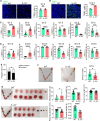An imbalance of the IL-33/ST2-AXL-efferocytosis axis induces pregnancy loss through metabolic reprogramming of decidual macrophages
- PMID: 35244789
- PMCID: PMC11073329
- DOI: 10.1007/s00018-022-04197-2
An imbalance of the IL-33/ST2-AXL-efferocytosis axis induces pregnancy loss through metabolic reprogramming of decidual macrophages
Abstract
During embryo implantation, apoptosis is inevitable. These apoptotic cells (ACs) are removed by efferocytosis, in which macrophages are filled with a metabolite load nearly equal to the phagocyte itself. A timely question pertains to the relationship between efferocytosis-related metabolism and the immune behavior of decidual macrophages (dMΦs) and its effect on pregnancy outcome. Here, we report positive feedback of IL-33/ST2-AXL-efferocytosis leading to pregnancy failure through metabolic reprogramming of dMΦs. We compared the serum levels of IL-33 and sST2, along with IL-33 and ST2, efferocytosis and metabolism of dMΦs, from patients with normal pregnancies and unexplained recurrent pregnancy loss (RPL). We revealed disruption of the IL-33/ST2 axis, increased apoptotic cells and elevated efferocytosis of dMΦs from patients with RPL. The dMΦs that engulfed many apoptotic cells secreted more sST2 and less TGF-β, which polarized dMΦs toward the M1 phenotype. Moreover, the elevated sST2 biased the efferocytosis-related metabolism of RPL dMΦs toward oxidative phosphorylation and exacerbated the disruption of the IL-33/ST2 signaling pathway. Metabolic disorders also lead to dysfunction of efferocytosis, resulting in more uncleared apoptotic cells and secondary necrosis. We also screened the efferocytotic molecule AXL regulated by IL-33/ST2. This positive feedback axis of IL-33/ST2-AXL-efferocytosis led to pregnancy failure. IL-33 knockout mice demonstrated poor pregnancy outcomes, and exogenous supplementation with mouse IL-33 reduced the embryo losses. These findings highlight a new etiological mechanism whereby dMΦs leverage immunometabolism for homeostasis of the microenvironment at the maternal-fetal interface.
Keywords: Decidual macrophages; Efferocytosis; IL-33/ST2 axis; Metabolic immune reprogramming; Recurrent pregnancy loss.
© 2022. The Author(s), under exclusive licence to Springer Nature Switzerland AG.
Conflict of interest statement
The authors declare no conflict of interest.
Figures








References
MeSH terms
Substances
Grants and funding
LinkOut - more resources
Full Text Sources
Research Materials
Miscellaneous

